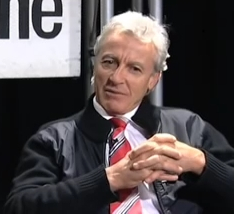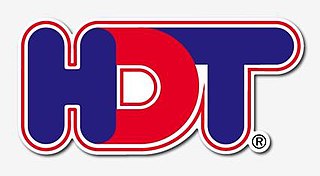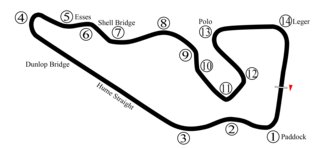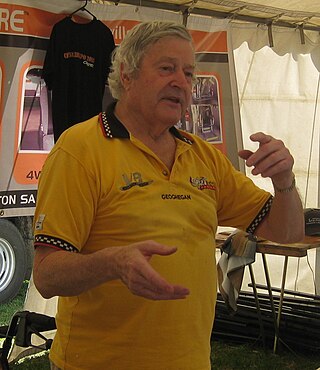
Peter Geoffrey Brock, known as "Peter Perfect", "The King of the Mountain", or simply "Brocky", was an Australian motor racing driver. Brock was most often associated with Holden for almost 40 years, although he raced vehicles of other manufacturers including BMW, Ford, Volvo, Porsche and Peugeot. He won the Bathurst 1000 endurance race nine times, the Sandown 500 touring car race nine times, the Australian Touring Car Championship three times, the Bathurst 24 Hour once and was inducted into the V8 Supercars Hall of Fame in 2001. Brock's business activities included the Holden Dealer Team (HDT) that produced Brock's racing machines as well as a number of modified high-performance road versions of his racing cars.

The Holden Dealer Team (HDT) was Holden's semi-official racing team from 1969 until 1986, primarily contesting Australian Touring Car events but also rallying, rallycross and Sports Sedan races during the 1970s. From 1980 the Holden Dealer Team, by then under the ownership of Peter Brock, diversified into producing modified road-going Commodores and other Holden cars for selected dealers via HDT Special Vehicles.
Allan George MoffatOBE is a Canadian-Australian racing driver known for his four championships in the Australian Touring Car Championship, six wins in the Sandown 500 and his four wins in the Bathurst 500/1000. Moffat was inducted into the V8 Supercars Hall of Fame in 1999.
The 1987 Australian Touring Car Championship was a motor racing competition which was open to Touring Cars complying with regulations as defined by the Confederation of Australian Motor Sport and based on FIA Group A rules. The championship, which was the 28th Australian Touring Car Championship, began on 1 March 1987 at Calder Park Raceway and ended on 5 July at Oran Park Raceway after nine rounds. The Calder round saw the world debut of the racing versions of the BMW M3, the Ford Sierra RS Cosworth and the Alfa Romeo 75 Turbo.
The 1991 Australian Touring Car Championship was a CAMS sanctioned motor racing title open to Group 3A Touring Cars. The title, which was the 32nd Australian Touring Car Championship, was contested over a nine-round series which began on 24 February 1991 at Sandown Raceway and ended on 11 August at Oran Park Raceway, The series was promoted as the Shell Australian Touring Car Championship and was won by Jim Richards driving a Nissan Skyline GT-R.
The Ford works team was the unofficial name for an Australian motor racing team which was supported by the Ford Motor Company of Australia. The team was formed in 1962 and was disbanded when Ford Australia withdrew from motor racing at the end of 1973. Drivers for the works team included Allan Moffat, Fred Gibson, Harry Firth, Bob Jane, Barry Seton, Bruce McPhee, John French, Ian Geoghegan and his brother Leo Geoghegan. Ford Australia also supported a factory rally team in Australia from 1977 to 1980.

The 1978 Hardie-Ferodo 1000 was the 19th running of the Bathurst 1000 touring car race. It was held on 1 October 1978, at the Mount Panorama Circuit just outside Bathurst. The race was open to cars eligible to the locally developed CAMS Group C touring car regulations with three engine capacity based classes.

The 1976 Hardie-Ferodo 1000 was the 17th running of the Bathurst 1000 touring car race. It was held on 3 October 1976 at the Mount Panorama Circuit just outside Bathurst in New South Wales, Australia. The race was open to cars complying with CAMS Group C Touring Car regulations.
The 1999 Australian Drivers' Championship was a CAMS sanctioned motor racing title open to drivers of Formula Holden racing cars. The winner of the championship, which was the 43rd Australian Drivers' Championship, was awarded the 1999 CAMS Gold Star. Due to a sponsorship arrangement with Holden, the championship was promoted as the "Holden Australian Drivers' Championship".
John Francis Harvey was an Australian racing driver. He was a top Speedcar driver for many years in the 1950s and 1960s, winning many championship races including the NSW Championship for three successive years and the Victorian Championship twice before turning his skills to road racing where he had a long and successful career until his retirement at the end of 1988. In 1987 John made history driving the General Motors Sunraycer to victory in the inaugural World Solar Challenge from Darwin to Adelaide, the first international race for purely solar powered cars.
The 1989 Australian Touring Car Championship was a CAMS sanctioned Australian motor racing title open to Group 3A Touring Cars. The championship, which was the 30th Australian Touring Car Championship, began on 5 March at Amaroo Park and ended on 9 July at Oran Park Raceway after eight rounds. The 1989 Australian Manufacturers' Championship was contested over the same eight round series.
The 1988 Australian Touring Car Championship was a CAMS sanctioned motor racing title for drivers of Group 3A Touring Cars. It was the 29th running of the Australian Touring Car Championship. The championship began on 6 March at Calder Park Raceway and ended on 17 July at Oran Park Raceway after nine rounds.

Warwick Farm Raceway was a motor racing facility which was in operation from 1960 to 1973. Warwick Farm Raceway hosted numerous major events during its life such as the Australian Grand Prix and rounds of both the Australian Touring Car Championship and the Tasman Series.
The 1985 Australian Touring Car Championship was a CAMS sanctioned motor racing title for drivers of Touring Cars. It was the 26th running of the Australian Touring Car Championship and the first to be contested using regulations based on the FIA's International Group A regulations after having been run under CAMS home grown Group C rules between 1973 and 1984. The championship began on 10 February 1985 at Winton Motor Raceway and ended on 14 July at Oran Park Raceway after ten rounds.
The 1982 Australian Touring Car Championship was a CAMS sanctioned Australian motor racing title open to Group C Touring Cars. It began on 18 February 1982 at Sandown Raceway and ended on 16 May at Oran Park Raceway after eight rounds. The title, which was the 23rd Australian Touring Car Championship, was won by defending champion Dick Johnson, driving a Ford XD Falcon.
The 1972 Australian Touring Car Championship was a CAMS sanctioned national motor racing title open to Group C Improved Production Touring Cars and Group E Series Production Touring Cars. The championship, which was the 13th running of the Australian Touring Car Championship, began at Symmons Plains and ended at Oran Park after eight rounds.

Leo Geoghegan was an Australian former racing driver. He was the elder of two sons of former New South Wales car dealer Tom Geoghegan, both of whom become dominant names in Australian motor racing in the 1960s. While his younger brother Ian "Pete" Geoghegan had much of his success in touring car racing, winning five Australian Touring Car Championships, Leo spent most of his racing career in open wheel racing cars.
Paul Stokell is an Australian racing driver. Highly decorated in every category he has competed, Stokell has been a race and multiple championship winning driver in open wheel, sportscar racing and tarmac rallying, consistently since the early 1990s and remains so today having won back to back Australian Targa Championship in 2018/2019.
Mark "Larko" Larkham is a retired Australian racing driver, former racing team owner and television commentator.
The 1970 Australian Drivers' Championship was a CAMS sanctioned motor racing title for drivers of Australian Formula 1 and Australian Formula 2 racing cars. The winner of the title, which was the fourteenth Australian Drivers' Championship, was awarded the 1970 CAMS Gold Star.





